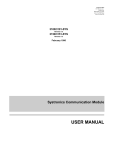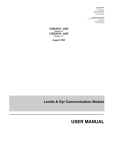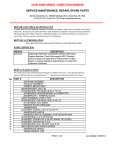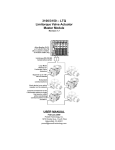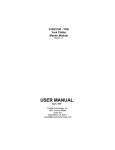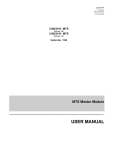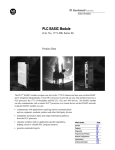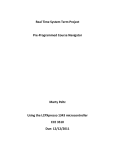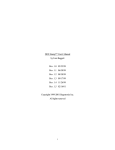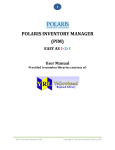Download 3100/3150-PCX User Manual
Transcript
3100/3150 - PCX MetOne Model PCX Master Module Revision 1.1 USER MANUAL November 1996 ProSoft Technology, Inc. 9801 Camino Media Suite 105 Bakersfield, CA 93311 [email protected] http://www.prosoft-technology.com Product Revision History 06/15/96 Revision 1.0 Initial release of product 11/16/96 Revision 1.10 Modified product to allow up to 32 slaves per port. i Implementation Guide Integration of the PCX module into a PLC or SLC application is easier the first time if a series of steps are followed. In order to assist the first time users of our products in getting the PCX operational quickly, we have come up with this step-by-step implementation guide. a) b) Starting with one of the ladder logic programs provided on disk with the PCX complete the following steps: PLC 5 PCX5 SLC 5/03 PCX503 (See Appendix for SLC programming tips) Edit the ladder logic provided on disk as needed for the application Verify rack and slot location in program Modify ladder instruction addresses as needed c) Setup the Communication Configuration parameters (See Section 2) Determine each port’s communication configuration requirements d) Setup the Polling List for each port (See Section 2) Be sure to review register map of slave device to build most effective memory map e) Identify the jumper requirements (See Appendix) f) Make up the communication cables (See Section 5) g) Place processor into the run mode h) Monitor the data table for the Master Error Status values (See Section 2) ii Table of Contents Revision History Implementation Guide i ii 1 Product Specifications ..............................................................................................................1 2 PCX Theoretical Operation.......................................................................................................1 2.1 Block Transferring Data to the Module ...............................................................................2 2.1.1 Communications Configuration [ BTW Block ID 255 ] ..................................................2 2.1.2 Writing Control Block to Module[ BTW Block ID 0 and 1 ]............................................3 2.2 Block Transferring data from the module............................................................................4 2.2.1 Reading Data from the Module[ BTR Block ID 0 and 25 ].............................................5 3 Protocol Commands .................................................................................................................7 3.1 PCX Commands ................................................................................................................7 3.1.1 128 to 191 - Counter Select .........................................................................................7 3.1.2 C - Clear Buffer ...........................................................................................................7 3.1.3 d - Start Counting (Counter controlled )........................................................................7 3.1.4 A - Send Record ..........................................................................................................8 4 Hardware Diagnostics...............................................................................................................8 4.1 3100 PLC Platform.............................................................................................................8 4.2 3150 SLC Platform.............................................................................................................9 5 Cable Connection ...................................................................................................................10 Appendix Support, Service and Warranty Jumper Configurations SLC Programming Considerations Example Ladder Logic PLC-5 SLC-5/03 1 Product Specifications The 3100/3150-PCX (“MetOne PCX Master Module”) product family allows Allen-Bradley 1771 and 1746 I/O compatible processors to easily interface as a host with MetOne Particle Counting Sensors. The PCX product includes the following standard features: • Two fully configurable serial ports, each capable of supporting the PCX Master functionality • Supports up to two(2) MetOne PCX 215W Counters per serial port • Support movement of binary, integer, ASCII, and floating point data types • Memory mapping will be pre-defined in the module to ease implementation in the ladder program • RS-485 connection from each port directly to PCX units • Software configuration (From processor ladder logic) Slave Addr : 0 to 31 (module adds 128 automatically) Command : Select command to be executed Parity : None (fixed) Stop Bit : 1 (fixed) Baud Rate : 300 TO 38,400 RTS to TxD : 50 ms (fixed) Timeout : 1 second Polling Rate : 1 second (fixed) • Response time The protocol drivers are written in Assembly and in a compiled higher level language. As such, the interrupt capabilities of the hardware are fully utilized to minimize delays, and to optimize the product's performance • Supported PCX command codes: Boot Sequence C Clear Buffer d Start Counting On Line Sequence A Poll data while receiving ‘#’ Poll until get data, then extract data • Operating Mode returned to ladder processor • Error Codes returned to the ladder processor 2 PCX Theoretical Operation Data transfers between the processor and the ProSoft Technology module occur using the Block Transfer commands, in the case of the PLC, and M0/M1 data transfer commands, in the case of the SLC. These commands transfer up to 64 physical registers per transfer. The logical data length changes depending on the data transfer function. The following discussion details the data structures used to transfer the different types of data between the ProSoft Technology module and the processor. The term 'Block Transfer' is used generically in the following discussion to depict the transfer of data blocks between the processor and the ProSoft Technology module. Although a true Block Transfer function does not exist in the SLC, we have implemented a pseudo-block transfer command in order to assure data integrity at the block level. Examples of the PLC and SLC ladder logic are included in Appendix A. In order for the ProSoft Technology module to function, the PLC must be in the RUN mode, or in the REM RUN mode. If in any other mode (Fault/PGM), the block transfers between the PLC and the module will stop, and communications will halt until block transfers resume. 1 2.1 Block Transferring Data to the Module Data transfer to the module from the processor is executed through the Block Transfer Write function. The different types of data which are transferred require slightly different data block structures, but the basic data structure is: Word 0 1-63 Description BTW Block ID code Data Although the full physical 64 words of the data buffer may not be used, the BTW and M0 lengths must be configured for 64 words otherwise module operation will be unpredictable. Where: BTW Block ID Code: A block identifier code between 0 and 255 in value. This code is used by the ProSoft module to determine what to do with the data block. Valid codes are: BTW Code Description 0 Port 1 Control Block 1 Port 2 Control Block 255 Module Communication Configuration Data: The data to be written to the module. The structure of the data is dependent on the Block ID code. The following sections provide details on the different structures. 2.1.1 Communications Configuration [ BTW Block ID 255 ] The ProSoft Technology firmware communication parameters must be configured at least once when the card is first powered up, and any time thereafter when the parameters must be changed. On power up, the module enters into a logical loop waiting to receive configuration data from the processor. While waiting, the module sets the second word of the BTR buffer to 255, telling the processor that the module must be configured before anything else will be done. The module will continuously perform block transfers until the communications configuration parameters block is received. Upon receipt, the module will begin execution of the command list if present, or begin looking for the command list from the processor. Issueing a 255 Configuration command will cause the module to act as if it had be powered down. The polling with all active slaves will be initialized with a Clear Buffer command (see Section 3) The configuration data block structure which must be transferred from the processor to the module is as follows: BTW Block ID 255 Word 0 1-10 11-20 BTW Buffer 0 Data Word Description BTW Block ID = 255 Port 1 Configuration parameters Port 2 Configuration parameters Description Block ID Header = 255 2 Port 1 Configuration 1 N[ ]:0 Baud Rate 2 N[ ]:1 Number of Slaves on port 3-10 N[ ]:2-9 Spare Port 2 Configuration 11 N[ ]:10 Baud Rate 12 N[ ]:11 Number of Slaves on port 13-20 N[ ]:12-19 Spare Where: Baud Rate: The baud rate at which the module is to operate. The baud rate is configured as follows: Value 0 1 2 3 4 5 6 7 Baud Rate 300 Baud 600 Baud 1200 Baud 2400 Baud 4800 Baud 9600 Baud 19200 Baud 38400 Baud The module’s two ports are limited to an upper baud rate of either 19200 or 38400 baud. The module cannot be configured with one port at 19200 and the other at 38400. If an attempt is made to configure the module in this fashion, a Port Configuration Error will be returned. Number of Slaves: The User is able to configure the number of slaves (counters) which will be connected to the PCX module. This parameter is used to optimize the module’s polling scheme (ie., limit the search for addresses) and to layout the memory map for data being returned to the module. Valid values for this entry is between 0 and 32. 2.1.2 Writing Control Block to Module[ BTW Block ID 0 and 1 ] The ProSoft Technology firmware communication parameters must be configured at least once when the card is first powered up, and any time thereafter when the parameters must be changed. Word 0 1-32 N[ ]:0 to N[ ]:31 Description BTW Block ID Number 0 - Port 1 1 - Port 2 Slave Poll Enable/Counter Address Where: BTW Block ID Number: This value determines which port the Control Block will be used to control. Slave Poll Enable/Counter Address: This field consists of a high byte and a low byte entry. The high byte is the Slave Poll Enable and the low byte is the Counter Address. Slave Poll Enable (High Byte) Entering a one (1) in this field will enable the slave to be polled. Placing a zero in this field will cause the polling to be halted. Enabling and disabling can be performed dynamically if desired. 3 Counter Address (Low Byte) The value entered here will be added to 128 when the Counter Select Command is issued (See Section 3). Counter addressing starts at 0 Slave Poll Enable/Counter Addresses 0 1 2 3 4 5 6 7 8 9 256 257 0 0 0 0 0 0 0 0 N9:10 0 0 0 0 0 0 0 0 0 0 N9:20 0 0 0 0 0 0 0 0 0 0 N9:30 0 0 0 0 0 0 0 0 0 0 N9:0 Port #1 Write Block to PCX Module (Addressing used in Example ladder logic) 2.2 Block Transferring data from the module When the Master port driver reads data from a slave, the resulting data is placed into the ProSoft module’s data space. This Module Data space is then transferred to the PLC/SLC. The transfer of data from the ProSoft Technology module to the processor is executed through the Block Transfer Read function. The data structure for the block transfer is predefine and detailed below. Although the full physical 64 words of the data buffer may not be used, the BTR and M1 lengths must be configured for a length of 64 words, otherwise module operation will be unpredictable The ladder logic must be programmed to look at the BTR buffer, decode several words, and then take action. The BTR buffer definition is: Word 0 1 2-62 Description BTR Block ID BTW Block ID Data Where: BTR Block ID Number: The ladder logic uses this value to determine the contents of the data portion of the BTR buffer. With some conditional testing in ladder logic, the data from the module can be placed into the PLC/SLC data table. BTW Block ID Number: The module returns this value to the processor to be used to enable the movement of the Slave Poll Enable/Counter Address blocks (0 and 1) to the module. Data: The contents of the module’s Register Data space containig the status and results of the polling of the slaves. The values will be 16 bit register values and floating point values, and should be placed into integer files. Note that the user application ladder logic controls the placement and use of the data registers. 4 2.2.1 Reading Data from the Module[ BTR Block ID 0 and 25 ] The data moved from the module to the ladder program is determined by the layout of the memory map. The structure of the read data block s is as follows: Word 0 1 2-51 Description BTR Block ID Number BTW Block ID Number Data In order to understand the movement of data from the module to the PLC, it is important to understand the building of the memory map in the module. Below is a diagram which shows the structure in the module for an example application. PLC Memory Module Memory Block Transfer (50 words / blk) N10:0 Counter Data Port 1 - Cntr 1 Port 1 - Cntr 2 Port 2 - Cntr 1 Port 2 - Cntr 2 N10:100 System Information Counter Data Structure The response data from the counters is returned in a contigous data block of 20 words to the PLC data table. The structure of the data is as follows: Word Description 0 ‘Send Data’ response counter 1 Device Status 2 Polling Stage 3 Communication Error 4-5 Sampling Period 6-7 Flow Rate (ml/min) 8-9 Concentration @ 2.0 micron 10-11 Concentration @ 4.0 micron 12-13 Concentration @ 5.0 micron 14-15 Concentration @ 10.0 micron 16-17 Concentration @ 15.0 micron 18-19 Concentration @ 20.0 micron Where: ‘Send Data’ response counter: This value represents a 0 to 32767 counter which increments each time a new data record is received from the counter. The counter will rollover to 0 at 32768. Device Status: This is a bit mapped value returned from the Counter as part of the data packet. The value returned from the Counter is masked with 0xdf in order to turn off the ‘F’ (the ‘F’ bit is always a 1 when returned from Counter). The status bit map is as follows: Bit Description 0 Calibrate Mode Fail 1 Low Battery or Wait (CNC) 2 Count Alarm 5 3 4 5 6 7 Model 231 Home fail or Low-high fluid Analog Alarms or Fill Masked out by PCX module Unused or Air Flow alarm Always 0 Polling Stage: Indicates the polling stage which the PCX module has reached when communicating with a Counter. The value of the stages are as follows (See Section 3 for command explanations): Value 0 1 2 Description Clear Buffer (C) Start Counter (d) Send Record (A) Communication Error: A non-zero number indicates the type of communciation error which is occuring with a Counter. This value is not latched and will therefore clear to 0 on the first successfull communciations. The values which can be expected in this field are: Value 0 1 3 8 254 255 Description All ok Low Flow (0 flow) forces conc values to 0 Error in response Timeout with Counter Checksum error in response TX Fail (Verify RTS to CTS jumper) Sampling Period: Data retuned from Counter. This value is entered in the Counter when the unit is configured for the application Flow Rate: The Flow rate is expected to be read from the instrument as the Analog Input AN0. The value read from the Counter is returrne in this field. The value returned is expected to be in the 100ml/min range. Concentration @ X micron: This is the calculated result determined by the PCX module by the following equation: ( particle count) / ( ( period / 60 ) * flow rate ) System Information Data Structure The module returns product information at the end of the counter data block. The structure of the data is as follows: Word Description 0-1 Product Name (ASCII) 2-3 Revision (ASCII) 4-5 Operating System Rev(ASCII) 6-7 Production Run Number (ASCII) Product Name: These two words represent the product name of the module in an ASCII representation. In the case of the PCX product, the letters ‘ PCX ‘ should be displayed when placing the programming software in the ASCII data representation mode. Revision : These two words represent the product revision level of the firmware in an ASCII representation. An example of the data displayed would be ‘1.00’ when placing the programming software in the ASCII data representation mode. 6 Operating System Revision : These two words represent the module’s internal operating system revision level in an ASCII representation. Production Run Number: This number represents the ‘batch’ number that your particular chip belongs to in an ASCII representation. Counter Status Polling Stage Communication Status ‘Send Data’ response counter Begin Floating Point Data N10:0 6 0 2 0 16382 0 0 0 0 0 N10:10 0 0 0 0 0 0 0 0 0 0 N10:20 8 0 2 0 16382 0 0 0 0 0 N10:30 0 0 0 0 0 0 0 0 0 0 N10:40 8 0 2 0 16382 0 0 0 0 0 N10:50 0 0 0 0 0 0 0 0 0 0 N10:60 8 0 2 0 16382 0 0 0 0 0 N10:70 0 0 0 0 0 0 0 0 0 0 N10:80 PC X 1. 0 0 08 01 0 0 0 Port 1 Slave #1 - Response/Status Port 1 Slave #2 - Response Status Port 2 Slave #1 - Response Status Port 2 Slave #2 - Response Status 0 Product Information Block Read Data Block from PCX Module 3 Protocol Commands The ProSoft Technology PCX module Master driver supports several commands from the PCX Command set. 3.1 PCX Commands The PCX module supports a command subset of the Protocol Specification consisting primarily of the commands required to intialize and read data from several units. The following sections detail the different commands supported by the module. Counter Select Prior to any one of the commands outlined in 3.1.2 through 3.1.4 a Counter Select command must be sent. 3.1.1 128 to 191 - Counter Select Functions as a slave address select. The counter are configured as address 0 to 63. The counter which matches (+128) the Counter Select command will respond to subsequence commands, until a new Counter Select value is transmitted. Power-Up Commands During the initial polling of a slave, either after power up or after being offline, the PCX module will issue a series of initialization commands. 3.1.2 C - Clear Buffer Clears the rotating buffer in the Met One unit. This command is issued prior to any other command to put the communications at a known state. 3.1.3 d - Start Counting (Counter controlled ) Allows the counter to begin counting and control the count cycle based on the front panel setting for the period (sample time). 7 Polling Commands During the regular polling of the slaves, the module will issue a command to each slave. 3.1.4 A - Send Record Commands the unit to send the next record in the buffer. When the rotating buffer is empty, the ‘#’ character is sent by the unit. If no count cycles have been completed since the counter was turned on, then the ‘#’ is also sent. No record is sent until the current count cycle is completed. 4 Hardware Diagnostics Several hardware diagnostics capabilities have been implemented using the LED indicator lights on the front of the module. The following sections explain the meaning of the individual LEDs for both the PLC and the SLC platforms. 4.1 3100 PLC Platform The following table documents the LEDs for the 3100-PCX module. ProSoft CIM Card ACTIVE CFG ERR1 TXD1 RXD1 ¡¡ ¡¡ ¡¡ ¡¡ ¡¡ FLT BPLN ERR2 TXD2 RXD2 Table 4.1 : PLC Platform LED Indication ProSoft CIM ACT A-B DB/B ACT Color Green Status Blink (Fast) On Blink ( 1/Sec) Off FLT FLT Red Off On CFG DH485 Green Off Blink On BPLN BTLO Red Off On ERR1 ERR2 LED1 LED2 Amber Off 8 Indication Normal state : The module is operating normally and successfully Block Transferring with the PLC The module is receiving power from the backplane, but there may be some other problem Indicates the module has somehow entered the Basic Programming Mode. Verify jumper JW4 (DB/B only) configuration. If all are correct, then contact the factory The module is attempting to Block Transfer with the PLC and has failed. The PLC may be in the PGM mode or may be faulted Normal State : No system problems are detected during background diagnostics A system problem was detected during background diagnostics. Please contact factory for technical support Normal state : No configuration related activity is occurring at this time This light blinks every time a Module Configuration block (ID = 255) is received from the processor ladder logic The light is on continuously whenever a configuration error is detected. The error could be in the Port Configuration data or in the System Configuration data. See Section 4 for details Normal State : When this light is off and the ACT light is blinking quickly, the module is actively Block Transferring data with the PLC Indicates that Block Transfers between the PLC and the module have failed.( Not activated in the initial release of the product) Normal State : When the error LED is off and the related port is actively transferring data, there are no communication errors Blink Periodic communication errors are occurring during data communications. This LED will stay on under several conditions: • CTS input is not being satisfied • Port Configuration Error • System Configuration Error • Unsuccessful comm on PCX slave • Recurring error condition on PCX master On Tx1 Tx2 Rx1 Rx2 4.2 PT1X PT2X PT1R PT2R Green Blink The port is transmitting data. Green Blink The port is receiving data 3150 SLC Platform The following table documents the LEDs for the 3150-PCX module. 3150-PCX COMMUNICATIONS ACT FAULT CFG BPLN PRT1 ERR1 PRT2 ERR2 Table 4.2 : SLC Platform LED Indication LED Name ACT Color Green Status Blink (Fast) On Blink ( 1/Sec) Off FLT Red Off On CFG Green Off Blink On BPLN Red Off On ERR1 ERR2 Amber Off Blink Indication Normal state : The module is operating normally and successfully Block Transferring with the SLC The module is receiving power from the backplane, but there may be some other problem Indicates the module has somehow entered the Basic Programming Mode. Verify jumper JW3 (BAS only) configuration. If all are correct, then contact the factory The module is attempting to Block Transfer with the SLC and has failed. The SLC may be in the PGM mode or may be faulted (Not in initial release) Normal State : No system problems are detected during background diagnostics A system problem was detected during background diagnostics. Please contact factory for technical support Normal state : No configuration related activity is occurring at this time This light blinks every time a Module Configuration block (ID = 255) is received from the processor ladder logic The light is on continuously whenever a configuration error is detected. The error could be in the Port Configuration data or in the System Configuration data. See Section 4 for details Normal State : When this light is off and the ACT light is blinking quickly, the module is actively Block Transferring data with the SLC Indicates that Block Transfers between the SLC and the module have failed Normal State : When the error LED is off and the related port is actively transferring data, there are no communication errors Periodic communication errors are occurring during data communications. See Section 4 to determine the error condition 9 On TxRx1 TxRx2 5 Green Blink This LED will stay on under several conditions: • CTS input is not being satisfied • Port Configuration Error • System Configuration Error • Unsuccessful comm on PCX slave • Recurring error condition on PCX master The port is communicating, either transmitting or receiving data Cable Connection The connection between the 3100/3150-PCX module and the MetOne counter unit is by an RS485 to the DB connections on the front of the module. The cable connections for both the 3100 and the 3150 units are shown below: Two Wire Mode (RS-485): Please be sure the jumper on the module is in the RS-485 mode. ProSoft Module 25-Pin 9-Pin 4 RTS 7 Foreign Device ---| 5 CTS 8 Jumper RTS to CTS ---- 14 TxRxD+ 9 -------------------- A(+) TxRxD+ 25 TxRxD- 1 -------------------- B(-) TxRxD- 7 GND -------------------- GND 5 10 Support, Service and Warranty Technical Support ProSoft Technology survives on its ability to provide meaningful support to its customers. Should any questions or problems arise, please feel free to contact us at: Factory/Technical Support ProSoft Technology, Inc. 9801 Camino Media, Suite 105 Bakersfield, CA 93311 (661) 664-7208 (800) 326-7066 (661) 664-7233 (fax) E-mail address: [email protected] Before calling for support, please prepare yourself for the call. In order to provide the best and quickest support possible, we will most likely ask for the following information (you may wish to fax it to us prior to calling): 1. 2. 3. 4. 5. Product Version Number Configuration Information Communication Configuration Jumper positions System hierarchy Physical connection information RS-232, 422 or 485 Cable configuration Module Operation Block Transfers operation LED patterns An after-hours answering system (on the Bakersfield number) allows pager access to one of our qualified technical and/or application support engineers at any time to answer the questions that are important to you. Module Service and Repair The PCX card is an electronic product, designed and manufactured to function under somewhat adverse conditions. As with any product, through age, misapplication, or any one of many possible problems, the card may require repair. When purchased from ProSoft Technology, the module has a one year parts and labor warranty according to the limits specified in the warranty. Replacement and/or returns should be directed to the distributor from whom the product was purchased. If you need to return the card for repair, it is first necessary to obtain an RMA number from ProSoft Technology. Please call the factory for this number and display the number prominently on the outside of the shipping carton used to return the card. General Warranty Policy ProSoft Technology, Inc. (Hereinafter referred to as ProSoft) warrants that the Product shall conform to and perform in accordance with published technical specifications and the accompanying written materials, and shall be free of defects in materials and workmanship, for the period of time herein indicated, such warranty period commencing upon receipt of the Product. This warranty is limited to the repair and/or replacement, at ProSoft's election, of defective or non-conforming Product, and ProSoft shall not be responsible for the failure of the Product to perform specified functions, or any other non-conformance caused by or attributable to: (a) any misapplication of misuse of the Product; (b) failure of Customer to adhere to any of ProSoft's specifications or instructions; (c) neglect of, abuse of, or accident to, the Product; or (d) any associated or complementary equipment or software not furnished by ProSoft. Support, Service and Warranty Limited warranty service may be obtained by delivering the Product to ProSoft and providing proof of purchase or receipt date. Customer agrees to insure the Product or assume the risk of loss or damage in transit, to prepay shipping charges to ProSoft, and to use the original shipping container or equivalent. Contact ProSoft Customer Service for further information. Limitation of Liability EXCEPT AS EXPRESSLY PROVIDED HEREIN, PROSOFT MAKES NO WARRANT OF ANY KIND, EXPRESSED OR IMPLIED, WITH RESPECT TO ANY EQUIPMENT, PARTS OR SERVICES PROVIDED PURSUANT TO THIS AGREEMENT, INCLUDING BUT NOT LIMITED TO THE IMPLIED WARRANTIES OF MERCHANT ABILITY AND FITNESS FOR A PARTICULAR PURPOSE. NEITHER PROSOFT OR ITS DEALER SHALL BE LIABLE FOR ANY OTHER DAMAGES, INCLUDING BUT NOT LIMITED TO DIRECT, INDIRECT, INCIDENTAL, SPECIAL OR CONSEQUENTIAL DAMAGES, WHETHER IN AN ACTION IN CONTRACT OR TORT (INCLUDING NEGLIGENCE AND STRICT LIABILITY), SUCH AS, BUT NOT LIMITED TO, LOSS OF ANTICIPATED PROFITS OR BENEFITS RESULTING FROM, OR ARISING OUT OF, OR IN CONNECTION WITH THE USE OR FURNISHING OF EQUIPMENT, PARTS OR SERVICES HEREUNDER OR THE PERFORMANCE, USE OR INABILITY TO USE THE SAME, EVEN IF PROSOFT OR ITS DEALER'S TOTAL LIABILITY EXCEED THE PRICE PAID FOR THE PRODUCT. Where directed by State Law, some of the above exclusions or limitations may not be applicable in some states. This warranty provides specific legal rights; other rights that vary from state to state may also exist. This warranty shall not be applicable to the extent that any provisions of this warranty is prohibited by any Federal, State or Municipal Law that cannot be preempted. Hardware Product Warranty Details Warranty Period : ProSoft warranties hardware product for a period of one (1) year. Warranty Procedure : Upon return of the hardware Product ProSoft will, at its option, repair or replace Product at no additional charge, freight prepaid, except as set forth below. Repair parts and replacement Product will be furnished on an exchange basis and will be either reconditioned or new. All replaced Product and parts become the property of ProSoft. If ProSoft determines that the Product is not under warranty, it will, at the Customer's option, repair the Product using current ProSoft standard rates for parts and labor, and return the Product freight collect. Support, Service and Warranty Jumper Configurations Hardware Overview When purchasing the PCX product, there are two choices. These choices are as follows: ProSoft Cat Num PLC SLC 3100 3150 Description Module provided by ProSoft When purchasing the module from ProSoft Technology, many of the jumper configurations will have been factory set. When purchasing the firmware from ProSoft Technology and the Allen-Bradley module from another source, particular attention must be paid to hardware configuration. Module Jumper Configurations The following section details the available jumper configurations for the 1771 and 1746 platform solutions. As needed, differences between the module based solutions and the firmware based solutions are highlighted. 3100 for the 1771 Platform Following are the jumper positions for the ProSoft Technology 3100-PCX module: Jumper JW1 JW2 JW3 JW4 JW5 JW6 JW7 JW8 JW9 3100 N/A N/A N/A Not Used 8 Pt Not Used Enabled As Needed As Needed JW5 Backplane 8/16 point The module should be operated in the 8 pt mode only. 8 Point JW7 Battery Enable / Disable Enabled This jumper should be placed in the Enabled position when the module is powered up. Although not critical to the operation of the module, this will back up some data registers in the module during a power failure or reset. JW8/9 RS Configuration for Port 1 and 2 See options on module The default from factory is RS-232, but all options are supported by the PCX firmware 3150 for the 1746 Platform Following are the jumper positions for the ProSoft Technology 3150-PCX module: Jumper JW1 JW2 JW3 JW4 JW1/2 3150-PCX As Needed As Needed N/A N/A RS configuration for port 1 and 2 See Appendix C The default from factory is RS-232, but all options are supported by the PCX firmware Jumper Configurations Communication Port Jumper Settings for 3150 Modules - JW1 & JW2 RS-232 RS-422 4-wire RS-485 2-wire RS-232 RS-422 4-wire RS-485 2-wire Jumper Configurations SLC Programming Considerations The 3150-PCX is also very easy to get operational. After the lPCX cover and firmware are installed and the jumpers have been configured, the module is ready to be configured. In order to implement the sample logic, the user must make sure that the correct processor and rack size match up. Also, should it be necessary to re-locate the PCX module, the user should be certain to configure the correct slot as a 1746-BAS 5/02 Configuration. When initially setting up the SLC program file, or when moving the module from one slot to another, the user must configure the slot to accept the PCX module. It is important that the slot containing the ProSoft module be configured as follows: 1746-BAS module or enter 13106 for the module code Configure the M0/M1 files for 64 words Configure I/O for 8 words The following is a step by step on how to configure these files using Allen-Bradley APS software. ICOM software users should follow similar steps. From the Main Menu: 1) Select the correct processor program and F3 for Offline programming 2) F1 for Processor Functions 3) F1 for Change Processor Modify the processor here if necessary (Note the PCX will only work with 5/02 or greater processors 4) F5 for Configure I/O Select 1746-BAS module for SLC 5/02 or greater, or enter 13106 for module code 5) F9 for SPIO Config when the correct slot is highlighted 6) F5 Advanced Setup 7) F5 for M0 file length - type in 64 and Enter 8) F6 for M1 file length - type in 64 and Enter Esc out and save configuration SLC Programming Considerations Example PLC and SLC Ladder Logic Overview The following ladder logic provides an example for the ladder logic necessary to integrate the 3100-PCX and the 3150-PCX modules into their respective processor platforms. This logic can be incorporated directly as is, or if desired modified as needed for the application. Data Files The examples use the same memory map for both of the platforms, with the exception of the actual block transfer data and control files. The memory map for the example application has been detailed in the attached data table listing. Slave Poll Enable/Counter Addresses 0 1 2 3 4 5 6 7 8 9 256 257 0 0 0 0 0 0 0 0 N9:10 0 0 0 0 0 0 0 0 0 0 N9:20 0 0 0 0 0 0 0 0 0 0 N9:30 0 0 0 0 0 0 0 0 0 0 N9:0 Counter Status Polling Stage Communication Status ‘Send Data’ response counter Begin Floating Point Data N10:0 6 0 2 0 16382 0 0 0 0 0 N10:10 0 0 0 0 0 0 0 0 0 0 N10:20 8 0 2 0 16382 0 0 0 0 0 N10:30 0 0 0 0 0 0 0 0 0 0 N10:40 8 0 2 0 16382 0 0 0 0 0 N10:50 0 0 0 0 0 0 0 0 0 0 N10:60 8 0 2 0 16382 0 0 0 0 0 N10:70 0 0 0 0 0 0 0 0 0 0 N10:80 PC X 1. 0 0 08 01 0 0 0 0 1 2 3 4 F11:0 0 0 0 0 0 F11:5 0 0 0 0 0 F11:10 0 0 0 0 0 F11:15 0 0 0 0 0 F11:20 0 0 0 0 0 F11:25 0 0 0 0 0 F11:30 0 0 0 0 0 F11:35 0 0 0 0 0 Example Ladder Logic Port 1 Slave #1 - Response/Status Port 1 Slave #2 - Response Status Port 2 Slave #1 - Response Status Port 2 Slave #2 - Response Status 0 Product Information Block Port 1 Slave #1 - Response/Status Port 1 Slave #2 - Response/Status Port 2 Slave #1 - Response/Status Port 2 Slave #2 - Response/Status





















